Job satisfaction survey template for enterprises: A strategic guide (2026)

Trying to assemble a piece of furniture without looking at the instructions because “how hard can it be?” At first, everything feels obvious, until suddenly you’ve got three extra screws, the drawer is upside down, and the whole thing wobbles if you breathe near it. Only then do you realize the manual wasn’t optional.
Employee experience works the same way. On the surface, everything may look fine, but hidden gaps can make the whole structure unstable. A job satisfaction survey template is that missing instruction guide. It shows you what’s aligned, what’s loose, and what needs reinforcement before things fall apart.
Use it well, and you don’t just fix problems, you build something sturdy, functional, and worth taking pride in.
- A job satisfaction survey template is a structured framework that helps organizations measure how fulfilled, motivated, and valued employees feel in their roles.
- A successful survey focuses on clarity, relevance, and anonymity to encourage honest feedback and reduce response bias.
- Using the right tool with multilingual support, scalability, and automated analytics ensures seamless execution and data accuracy.
- The survey’s impact depends on how leaders analyze results, communicate findings transparently, and act decisively on feedback.
- With CultureMonkey’s survey platform, you can create personalized, people science–backed job satisfaction surveys that turn employee feedback into actionable insights for stronger engagement.
What is an employee job satisfaction survey and why does it matter?

An employee job satisfaction survey measures morale, motivation, and workplace experience across roles and teams. Using a structured employee job satisfaction survey template ensures consistent questions, benchmarking, and actionable insights.
This approach reduces attrition, builds trust, and fosters a culture where feedback is valued and used to drive meaningful improvements.
An employee job satisfaction survey is a structured tool designed to measure how content and motivated employees feel in their roles, across different teams and functions. Unlike casual feedback channels, these surveys follow a defined framework that captures insights into areas such as work environment, leadership, compensation, career growth, and overall employee morale.
Using an employee job satisfaction survey template ensures that organizations ask the right questions consistently and benchmark results across departments or time periods. It eliminates guesswork and helps HR leaders focus on actionable data rather than scattered opinions.
Clients do not come first. Employees come first. If you take care of your employees, they will take care of the clients.
Whether it’s a global enterprise or a fast-scaling startup, structured templates bring discipline and credibility to the feedback process. Many organizations also adopt a staff satisfaction survey template to compare team-level performance and identify localized issues that might otherwise go unnoticed.
By systematically tracking satisfaction, companies can reduce attrition, build trust with employees, and create a workplace culture where feedback is truly valued.
What does a good job satisfaction survey template look like in 2026?
A modern survey template in 2026 isn’t just about collecting ratings, it’s about building trust, ensuring inclusivity, and making results actionable. HR leaders need tools that adapt to changing workforce expectations and global compliance standards.
A strong framework also ensures that employee satisfaction survey questions are relevant, unbiased, and aligned with enterprise goals.
- Mobile-first design: Surveys must be easy to complete on any device to boost participation.
- Localized language support: Employees should have the option to respond in their preferred language.
- Anonymous response pathways: Anonymity increases honesty and response rates.
- Mix of question formats: Blend quantitative scales with qualitative open-text feedback.
- Accessibility features: Support for screen readers and simplified layouts ensures inclusivity.
- Automated reminders: Gentle nudges across channels like email, Slack, or Teams help maximize completion rates.
- Template modularity: Allow HR teams to customize sections for leadership, workload, or career growth focus.
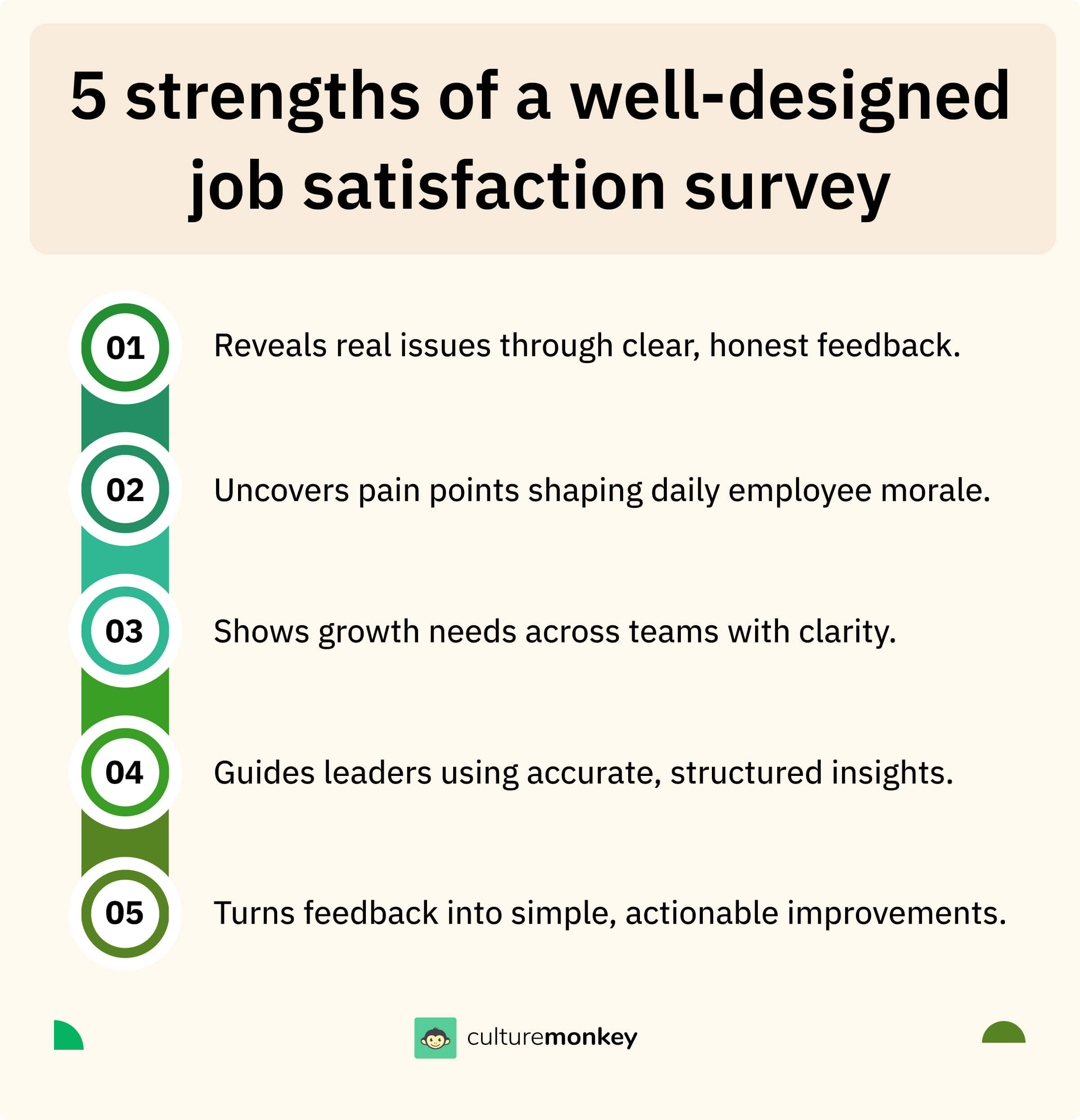
A well-designed survey template is only half the story, its real power lies in how you use it. Now that you know what a great template includes, let’s explore how to run your job satisfaction survey the right way.
How to do a job satisfaction survey, the right way?

Running a survey is like tuning a band before the show: small adjustments change the whole performance. Set the tempo with clarity, choose the right instruments, and test the sound. When everything’s aligned, your audience leans in, the rhythm holds, and your insights hit the right notes. Now, set the stage.
- Define clear objectives: Decide what success looks like and why it matters. Tie each goal to a metric on your job satisfaction assessment form so results map to actions, not noise. Prioritize morale, retention risks, leadership trust, or workload clarity before anything else, ensuring your employee satisfaction surveys drive meaningful change.
- Choose the right survey tool: Pick a secure, scalable platform with anonymous response options. Ensure it supports your employee survey form, survey for staff, and staff satisfaction survey form with multilingual delivery, dashboards, and exports. Reliability means leaders focus on insights, not wrangling spreadsheets or permissions, while using the right tools to measure employee satisfaction.
- Craft relevant questions: Use a template of employee satisfaction survey as a base, then tailor it. Blend Likert scales and open questions in your job satisfaction questionnaire to capture both measurable data and deeper context. Keep wording neutral, concise, and relevant to build clarity and accuracy across every sample job satisfaction survey.
- Pilot test the survey: Run a quick rehearsal with a small cross-section. A staff satisfaction survey template helps surface confusing items, broken logic, or timing issues before launch. Fix skip patterns, refine scales, confirm anonymity cues, and verify translations so participation starts strong and confidence in the survey process remains high.
- Distribute smartly: Meet people where they already are. Deliver links through email, Slack, or mobile channels to boost completion rates and reduce survey fatigue. Localize invites, clarify goals, and use your staff satisfaction survey template messaging to explain purpose and response time in clear, human language.
- Set a realistic timeline: Keep the window short enough to maintain momentum and long enough for thoughtful reflection. Most teams succeed within seven to fourteen days. Reference your employee job satisfaction survey template to plan reminders, avoid holidays, and coordinate manager communication effectively across all surveys for staff campaigns.
- Analyze and act: Move from data to decisions quickly. Use dashboards to segment responses by team, tenure, or location, and publish transparent “You said, we did” updates. Integrate findings into performance reviews, budget cycles, or a salary satisfaction survey to close the feedback loop and reinforce a culture of continuous improvement.
Even the best survey design falls flat without the right questions behind it.
Now that you know how to conduct your survey effectively, let’s uncover which question types inspire the most honest employee responses.
What types of questions drive the most honest employee responses?

The way a survey is framed often determines whether employees will answer honestly or hold back. A good workplace satisfaction template balances sensitivity with clarity, encouraging open and genuine responses. Using the right style of questions also makes the employee feedback form more actionable for HR teams.
Open-ended questions: Encourage employees to share context
Open-text questions give people the freedom to express feelings and experiences without being boxed into predefined choices. They reveal nuances that numbers alone can’t capture, which is why every HR satisfaction survey tool includes them.
Example questions:
- “What’s one thing that would make your workday easier?” (Open text response)
- “If you could change one aspect of your current role, what would it be?” (Open text response)
Likert scale questions: Capture measurable sentiment
Likert scales provide structured insights, letting HR leaders measure satisfaction trends over time. They’re essential in any workplace satisfaction template, making it possible to benchmark morale across teams.
Example questions:
- “On a scale of 1–5, how satisfied are you with your opportunities for growth?” (1 = Not satisfied at all, 5 = Extremely satisfied)
- “How fairly do you feel your contributions are recognized at work?” (1 = Very unfair, 5 = Very fair)
Multiple-choice questions: Provide clarity and focus
When designed well, multiple-choice questions help HR teams quickly identify patterns without overwhelming employees. They make an employee feedback form easier to complete, boosting overall participation rates.
Example questions:
- “Which factor most influences your job satisfaction?” (Options: Workload, Leadership, Pay, Career Growth)
- “What’s the biggest barrier to being productive in your role?” (Options: Lack of tools, Communication gaps, Managerial support, Other)
Pulse-check questions: Build trust with quick check-ins
Short, recurring questions create a habit of feedback and reduce survey fatigue. They’re a must-have feature in modern HR satisfaction survey tools, helping enterprises track changes in real time.
Example questions:
- “How motivated do you feel at work this week?” (Scale: 1 = Not at all motivated, 10 = Highly motivated)
- “Do you feel supported by your manager right now?” (Options: Yes, No, Sometimes)
45+ Must have questions to include in your job satisfaction survey
A comprehensive job satisfaction survey template needs to strike a balance between quantitative and qualitative insights. Questions should cover all aspects of the employee experience, workload, leadership, recognition, growth, and overall culture.
Including well-structured rating scales ensures results are measurable and easy to analyze, while still leaving room for employees to share open feedback.
General Job Satisfaction
-
1
How satisfied are you with your current role?
(1 = Not satisfied at all → 5 = Extremely satisfied)
-
2
How meaningful do you find your work?
(1 = Not meaningful → 5 = Very meaningful)
-
3
How motivated are you to come to work each day?
( 1–10 scale)
-
4
How likely are you to recommend this company as a great place to work?
( 1–10 scale)
-
5
Do you feel proud to work at this company?
(Yes/No → Somewhat)
-
6
Do you feel your job makes good use of your strengths?
( 1–5 scale)
Work Environment & Culture
-
1
How inclusive do you feel our workplace culture is?
(1 = Not inclusive → 5 = Very inclusive)
-
2
How safe do you feel expressing your opinions at work?
( 1–5 scale)
-
3
How well does your team collaborate on projects?
( 1–5 scale)
-
4
Do you feel your contributions are respected by colleagues?
( 1–5 scale)
-
5
How satisfied are you with the company’s commitment to diversity and equity?
( 1–5 scale)
-
6
Do you feel connected to your colleagues on a personal level?
( 1–5 scale)
Leadership & Management
-
1
How confident are you in your manager’s ability to lead the team?
( 1–5 scale)
-
2
Does your manager provide you with regular constructive feedback?
(Yes/No → Sometimes)
-
3
How approachable is your manager when you need support?
( 1–5 scale)
-
4
Do you feel leadership communicates company goals clearly?
( 1–5 scale)
-
5
How fairly do you feel leadership makes decisions?
( 1–5 scale)
-
6
How much trust do you have in senior leadership?
( 1–5 scale)
Career Growth & Development
-
1
How satisfied are you with opportunities for professional growth?
( 1–5 scale)
-
2
Do you feel you receive adequate training to do your job well?
( 1–5 scale)
-
3
How supported do you feel in achieving your career goals?
( 1–5 scale)
-
4
How effective are mentorship opportunities in the company?
( 1–5 scale)
-
5
Do you feel your skills are being fully utilized?
(Yes/No → Sometimes)
-
6
How confident are you in your long-term career prospects here?
( 1–5 scale)
Compensation & Benefits
-
1
How satisfied are you with your compensation?
( 1–5 scale)
-
2
How fairly do you feel you are paid compared to your peers?
( 1–5 scale)
-
3
How satisfied are you with the company’s benefits package?
( 1–5 scale)
-
4
Do you believe your workload is fair for your pay?
( Yes/No)
-
5
How competitive do you feel our compensation is compared to the market?
( 1–5 scale)
-
6
How satisfied are you with non-monetary perks (flexibility, wellness, etc.)?
( 1–5 scale)
Workload & Work-Life Balance
-
1
How manageable is your current workload?
( 1–5 scale)
-
2
Do you feel you have a healthy work-life balance?
( 1–5 scale)
-
3
How often do you feel stressed due to work?
(1 = Never → 5 = Very often)
-
4
How flexible are your working hours?
( (Yes/No))
-
5
Do you feel supported when requesting time off?
(Yes/No → Sometimes)
-
6
How often do you need to work beyond your normal hours?
(1 = Never → 5 = Always)
Recognition & Rewards
-
1
How often do you feel recognized for your work?
(1 = Never → 5 = Always)
-
2
Do you feel recognition is distributed fairly across teams?
(Yes/No → Sometimes)
-
3
How satisfied are you with the way your contributions are acknowledged?
( 1–5 scale)
-
4
Do rewards and recognition motivate you to perform better?
(Yes/No → Sometimes)
-
5
How valued do you feel by the company overall?
( 1–5 scale)
-
6
How timely is recognition when you achieve something significant?
( 1–5 scale)
Communication & Feedback
-
1
How effective is communication within your team?
( 1–5 scale)
-
2
Do you feel leadership is transparent with important company updates?
( 1–5 scale)
-
3
How often do you receive constructive feedback on your performance?
(1 = Rarely → 5 = Very often)
-
4
How easy is it for you to share feedback upwards?
( 1–5 scale)
-
5
Do you feel your feedback leads to meaningful change?
(Yes/No → Sometimes)
-
6
How satisfied are you with cross-departmental communication?
( 1–5 scale)
Future Outlook & Retention
-
1
How likely are you to stay with the company for the next 12 months?
( 1–10 scale)
-
2
Do you feel the company is moving in the right direction?
(Yes/No → Not Sure)
-
3
How aligned do you feel with the company’s long-term vision?
( 1–5 scale)
-
4
How confident are you about your future in this organization?
( 1–5 scale)
-
5
Would you consider leaving the company if offered a similar role elsewhere?
(Yes/No → Maybe)
-
6
How committed are you to growing your career here long term?
( 1–5 scale)

Access high-impact survey questions to evaluate workplace satisfaction and motivation
Download nowKnowing the right questions is just the starting point, how you present them makes all the difference.Now that we’ve covered what to ask, let’s explore how to design a job satisfaction survey that employees actually complete.
How to design a job satisfaction survey template that employees actually complete
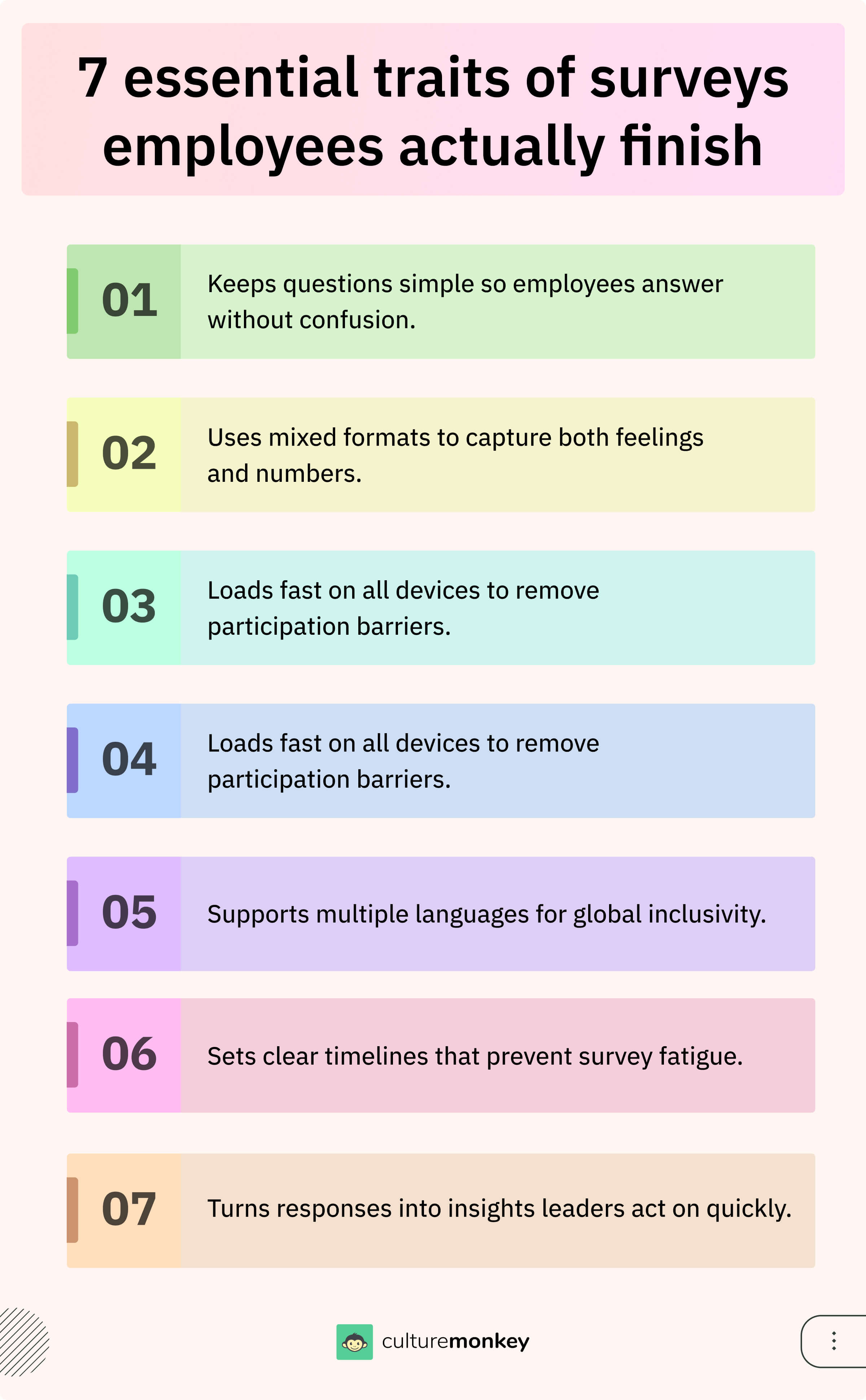
Creating genuine satisfaction is like tuning an orchestra, every instrument matters, but harmony only happens when all play in sync. In the same way, true workplace happiness isn’t just about pay. It’s about balance, recognition, and purpose.
A thoughtful employee satisfaction survey form or HR satisfaction survey questionnaire helps leaders discover what really makes their teams thrive.
- Keep it simple and clear: Clarity drives completion. Write questions in plain language for your employee satisfaction surveys templates and avoid HR jargon or abstract phrases. The simpler the wording, the easier it is for employees to connect, respond, and share honest feedback.
- Use a mix of question types: Blend Likert scales, multiple-choice, and open-ended prompts in your job satisfaction survey or work satisfaction survey. This helps gather both measurable data and deeper emotional insights, the perfect balance for effective employee feedback.
- Ensure anonymity: Employees share genuine opinions only when they feel safe. Keep your employee job satisfaction survey anonymous, protecting identities to build trust and increase participation rates across departments and hierarchies.
- Optimize for mobile participation: A mobile-friendly template employee survey allows your workforce, especially hybrid or remote teams, to respond anytime, anywhere. Accessibility boosts response rates and ensures inclusivity in your enterprise satisfaction efforts.
- Provide clear timelines: Communicate the start and end dates clearly within your HR satisfaction survey or employee satisfaction survey. Short, structured timelines prevent fatigue and encourage timely participation while maintaining data reliability.
- Send reminders across channels: Use integrated reminders through Slack, Teams, or email. Personalized messages in your employee satisfaction survey templates remind participants why their voice matters and how their feedback drives organizational improvement.
- Share results and next steps: Transparency converts data into trust. Present highlights from your employee satisfaction survey in engaging visuals and outline action steps so employees see tangible outcomes from their feedback.
- Communicate the purpose upfront: Begin every HR satisfaction survey questionnaire by explaining why the survey matters. Context builds ownership and ensures thoughtful, authentic responses that truly reflect workplace sentiment.
- Always close the loop: Publish “You said, we did” updates from your work satisfaction survey. Demonstrating action proves your employee satisfaction surveys templates aren’t box-checking exercises, they’re the foundation of a feedback-driven culture employees can believe in.
Once your job satisfaction employee satisfaction survey template is well-designed, personalization becomes essential, especially when different teams need tailored workplace happiness survey prompts that reflect diverse roles, cultures, and expectations across global or distributed workforces.
How to customize a satisfaction survey question for different departments or locations?
Not every team or region experiences the workplace in the same way, which makes customization essential. A generic job satisfaction survey template provides a strong starting point, but adapting questions ensures relevance and accuracy.
Using an employee satisfaction survey tailored to each function or location helps uncover unique challenges and opportunities.
- Identify department-specific drivers: For sales, focus on incentives and targets; for engineering, workload and tools may matter more.
- Adapt language to local culture: Use regionally appropriate terms and phrases to make surveys relatable.
- Include location-based questions: Ask about local leadership support, office facilities, or remote work experience.
- Balance global and local metrics: Keep a core set of universal questions while adding tailored ones for departments or regions.
- Test for cultural sensitivity: Ensure wording respects cultural norms and avoids misunderstandings.
- Adjust question formats by role: For field teams, keep surveys shorter; for corporate roles, allow more detailed input.
- Use benchmarking consistently: Compare customized responses back to the company-wide baseline for meaningful analysis.
Customization helps you capture what truly matters to each team, but even the best intentions can go wrong without careful design. Now that we’ve seen how to tailor surveys for different contexts, let’s look at the common mistakes enterprises make and how to fix them.
Common mistakes enterprises make when designing surveys (and how to fix them)
Designing surveys may seem straightforward, but small mistakes can derail participation and data quality. Enterprises often overlook key details that affect how employees respond and whether results can be trusted.
Using a well-structured employee satisfaction survey template helps avoid these pitfalls and ensures actionable insights.
- Asking too many questions: Overly long surveys cause fatigue and lower completion rates. Keep surveys short and focused on essential areas of employee experience. Use clear prioritization to avoid overwhelming employees.
- Using vague or biased wording: Questions that are unclear or misleading can skew results. Write neutral, specific questions that employees can answer with confidence. Test wording on a small group before rollout.
- Ignoring anonymity: Without anonymity, employees may hold back honest opinions. Always reassure participants their responses are anonymous. An employee satisfaction survey template with built-in anonymity is key.
- Failing to align with business goals: Surveys often ask questions that don’t link to organizational priorities. Align each question with metrics leadership can act upon. This creates a clear line from data to decision-making.
- Skipping pilot testing: Launching without testing can expose flaws in design or phrasing. A pilot run with a small sample helps refine questions. This ensures smoother execution in the full rollout.
- Not segmenting by teams or roles: A one-size-fits-all approach hides unique departmental issues. Add filters for role, tenure, or location so leaders can uncover actionable insights at a granular level.
- Neglecting follow-up communication: Employees lose trust when surveys disappear into a black hole. Share results and action steps transparently. Closing the loop motivates participation in future surveys.
GDPR, SOC2, and compliance considerations for survey distribution?
Enterprises must treat survey data with the same rigor as other sensitive employee information. Compliance with standards like GDPR and SOC2 is not optional—it’s a foundation for trust and legal protection. When distributing surveys at scale, these considerations ensure both security and credibility.
- Data privacy under GDPR: Collect only essential information, obtain clear consent, and give employees the right to access or delete their responses.
- SOC2 security standards: Ensure your survey platform has controls for data security, availability, and anonymity to meet enterprise audit requirements.
- Anonymity and data minimization: Avoid collecting identifiable data unless absolutely necessary, and communicate how responses remain anonymous.
- Role-based platform access: Limit survey data visibility to super admins, HR leaders, or managers as appropriate. This prevents unnecessary exposure and strengthens compliance.
Collecting feedback securely is just the beginning, what you do with it defines your culture. Now that we’ve covered the compliance side of survey distribution, let’s explore how to analyze and act on job satisfaction survey results effectively.
How do you analyze and act on job satisfaction survey results?

Collecting feedback is only the first step, real impact comes from how the data is interpreted and applied. Enterprises must turn insights into tangible actions to strengthen culture, boost retention, and improve employee experience. Using a template of employee satisfaction survey ensures results are structured and easy to analyze.
- Segment your data: Break down results by department, role, or location to identify patterns and localized issues. This helps uncover challenges that might be hidden in company-wide averages.
- Prioritize key drivers: Focus on themes like workload, recognition, and leadership support that directly impact satisfaction scores. Ranking issues by importance ensures resources are allocated where they create the biggest impact.
- Visualize with dashboards: Use heatmaps, trend charts, and benchmarks to make findings clear for leadership and managers. Visual storytelling turns complex data into insights executives can act on quickly.
- Build collaborative action plans: Involve managers in creating step-by-step plans that address issues revealed in the survey. Shared ownership increases accountability and ensures changes are implemented across teams.
- Communicate outcomes transparently: Share highlights of the results and the actions being taken so employees see their feedback driving change. Closing the loop builds trust and encourages higher participation in future surveys.
Once analysis begins, the real power emerges when your job satisfaction index survey informs wider HR strategy, strengthens executive reporting, and helps organizations link employee sentiment survey patterns to retention, performance, and long-term engagement in the workplace.
Using job satisfaction scores to inform HR strategy and executive reporting
Survey scores aren’t just numbers, they’re strategic signals that help HR teams shape culture, improve retention, and align with business outcomes. When properly tracked, job satisfaction metrics reveal where leadership must act and how employees perceive organizational priorities. For executives, these insights transform raw data into meaningful workforce intelligence.
- Identify retention risks: Low scores in areas like workload or recognition highlight potential attrition hotspots. HR leaders can act early with tailored retention programs.
- Benchmark progress over time: Comparing scores across quarters or years shows whether cultural initiatives are driving measurable improvement. This trend data supports long-term strategy.
- Link scores to business outcomes: Correlating satisfaction scores with productivity, turnover, or customer satisfaction makes a stronger business case for HR investments.
- Enable data-driven decision making: Executives gain clarity on where to allocate resources—whether for training, wellness, or leadership development. Survey data adds weight to strategic recommendations.
- Strengthen leadership accountability: Presenting team-level scores creates ownership among managers. When leaders see how their teams compare, they’re motivated to take corrective action.
- Spot engagement disparities across teams: Satisfaction data segmented by role, tenure, or geography highlights where specific groups are struggling. This enables targeted interventions rather than one-size-fits-all solutions.
- Support transparent executive reporting: Sharing high-level scores in board reports or all-hands meetings builds trust. It signals that leadership values employee voices and ties culture directly to company performance.
Data becomes powerful only when it shapes real decisions.Now that you know how to interpret survey results strategically, let’s look at the top job satisfaction survey tools enterprises use to turn insights into action.
Top 5 job satisfaction survey tools for enterprises (Features, Pros and Cons)
Choosing the right survey tool can be overwhelming, with countless platforms claiming to improve employee engagement. To help enterprises make an informed choice, we’ve shortlisted five leading solutions that stand out in functionality, scalability, and ease of use.
The following analysis is grounded in real customer feedback and reviews gathered from trusted platforms such as G2 and Capterra, offering a balanced view of both strengths and shortcomings.
1. CultureMonkey
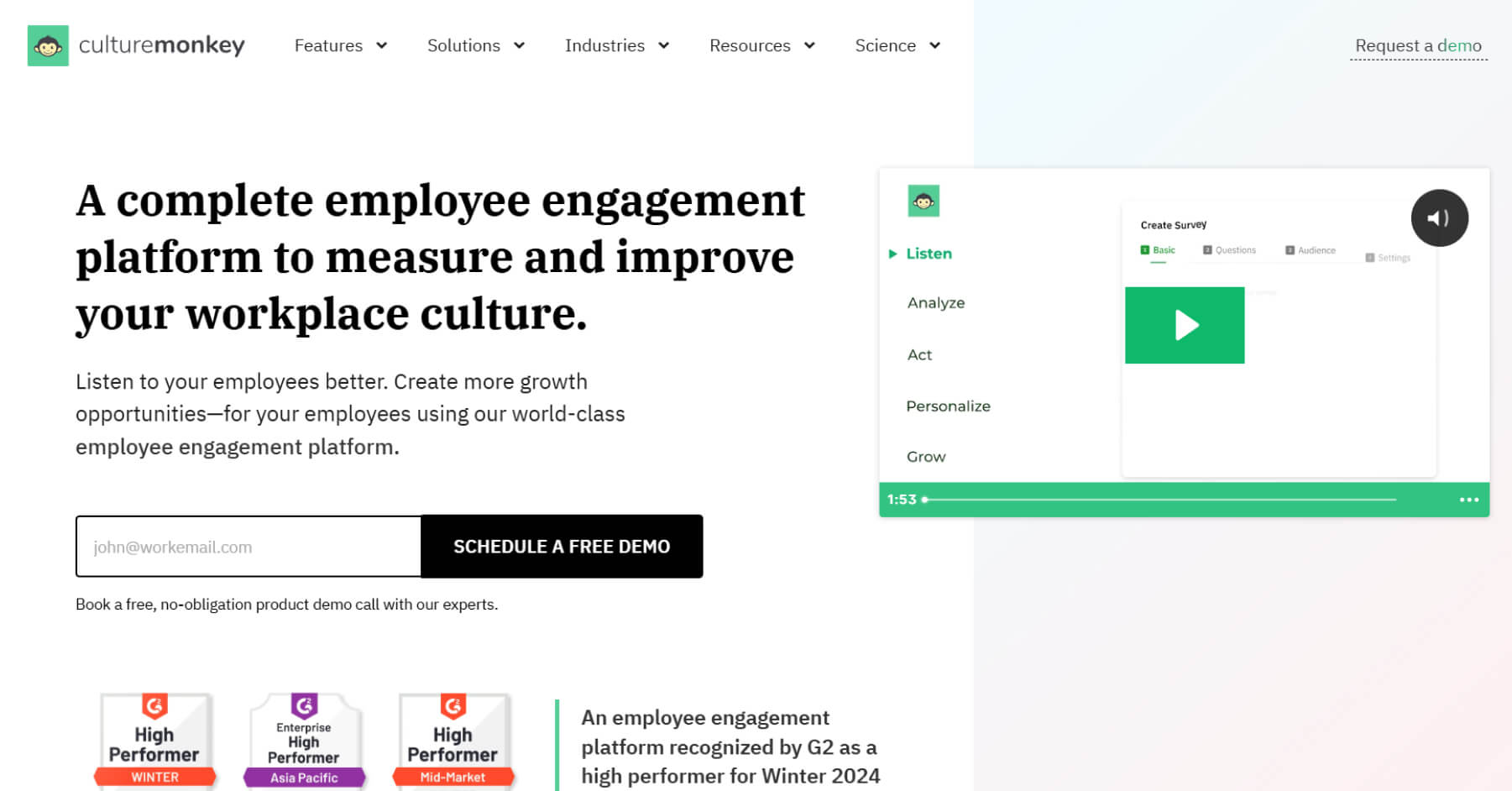
CultureMonkey is an employee engagement survey platform built to meet the complex needs of large organizations. The platform provides HR leaders with secure, scalable, and customizable tools to measure job satisfaction, track engagement, and uncover cultural drivers across diverse teams.
With features grounded in People Science and enterprise-grade compliance, CultureMonkey enables leadership to listen at scale, act with precision, and build workplaces where employees feel valued and heard.
Key Takeaways
2. Qualtrics
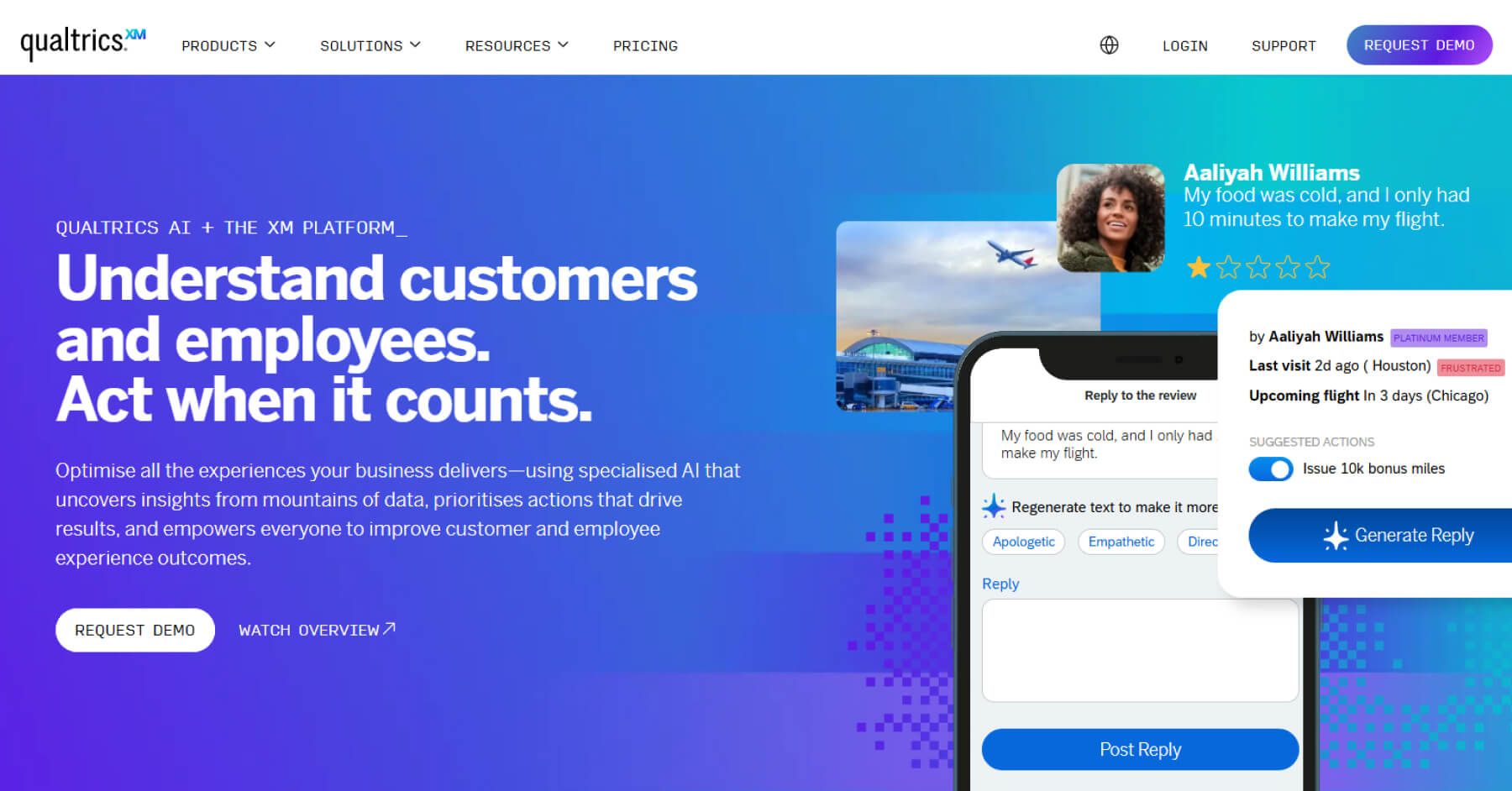
Qualtrics is a survey and experience management platform widely used across industries. The platform offers flexible tools to design, distribute, and analyze surveys at scale, with strong support for customization and compliance. For HR teams, Qualtrics enables structured employee feedback collection to inform decision-making and cultural initiatives.
Key Takeaways
3. Leapsome
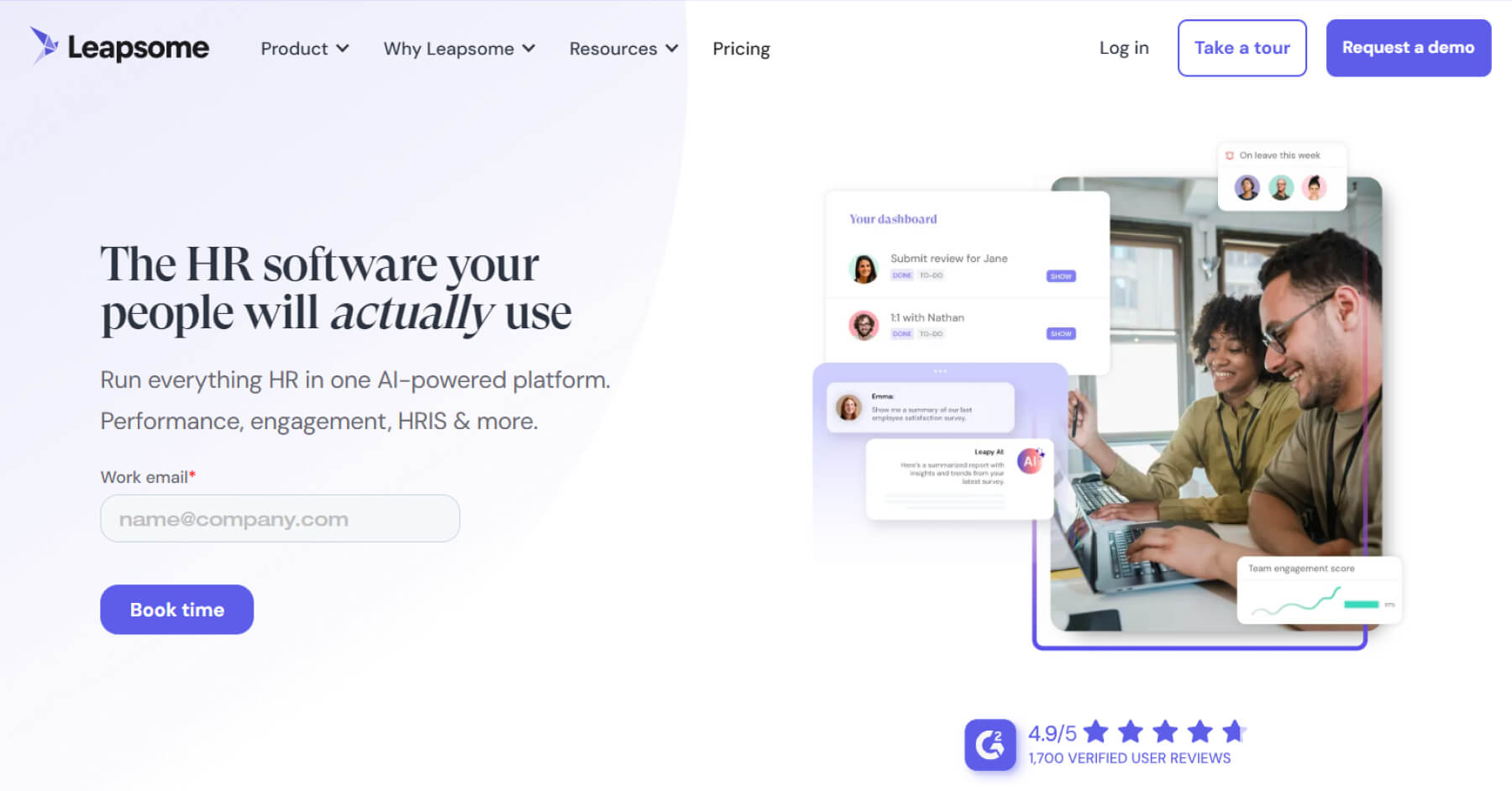
Leapsome is a HR platform that combines performance reviews, feedback, learning, and engagement tools. The platform integrates HRIS functionality with survey & feedback mechanisms, making it possible to capture trends, align goals, and support continuous development.
Key Takeaways
4. Lattice

Lattice blends engagement surveys, performance management, and analytics into one people-platform to help organizations gather feedback and act on it. Lattice emphasizes clarity, connections between survey data and people outcomes, and strong integrations so feedback becomes part of everyday insights.
Key Takeaways
5. Officevibe
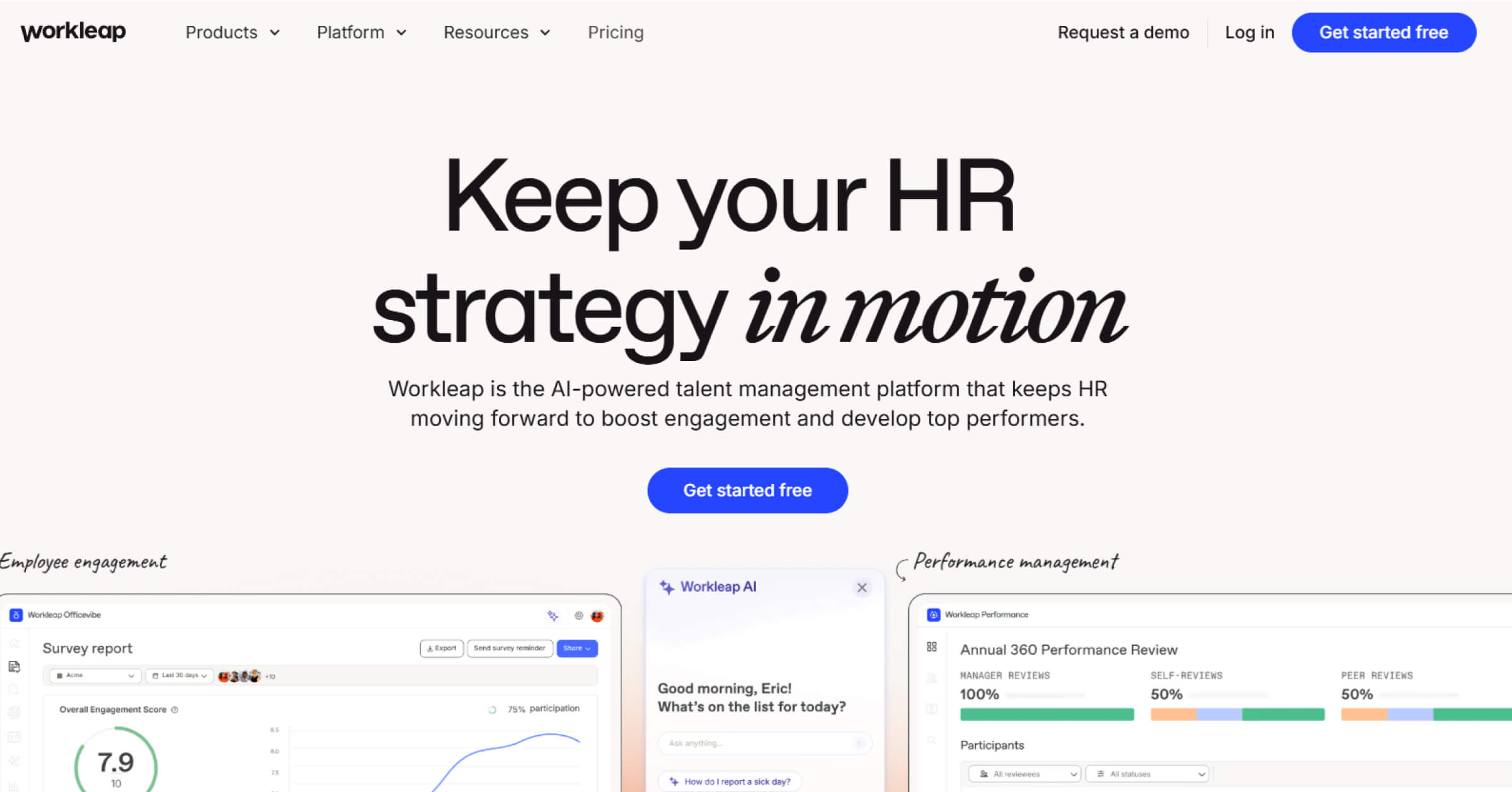
Workleap Officevibe delivers a survey and feedback platform designed for continuous employee engagement. The enables to send bite-sized pulse surveys with customizable full-cycle questionnaires, enabling organizations to track sentiment over time, capture insights, and act quickly.
Key Takeaways
How does CultureMonkey help you design, analyze, and act on job satisfaction surveys?
Enterprises need more than just survey distribution, they need a platform that simplifies feedback, builds trust, and turns responses into strategy. That’s where the CultureMonkey employee engagement survey platform stands out.
CultureMonkey empowers HR leaders to design surveys, capture honest feedback, and deliver insights that drive measurable cultural change.
- Customizable templates and survey design: Start with proven job satisfaction survey templates or adapt them for specific departments, locations, or roles. Flexible design ensures the survey matches organizational needs.
- Anonymous response collection: Built-in anonymity makes employees more comfortable sharing their true thoughts, driving higher participation and more reliable data.
- People science-backed analytics: Go beyond raw scores with advanced analytics powered by behavioral science. CultureMonkey highlights key drivers of satisfaction and surfaces trends across teams and geographies.
- Role-based dashboards: Super admins, HR leaders, and managers each get tailored views of survey results. This ensures the right stakeholders see the right insights to act quickly.
- Action planning and follow-through: Translate insights into collaborative action plans with Kanban-style boards. Managers and HR teams can assign ownership, track progress, and close the feedback loop effectively.
Conclusion
A strong job satisfaction survey template gives organizations a structured way to understand how employees truly feel about their roles, growth, and daily experiences. When used consistently, a job satisfaction survey uncovers what drives motivation, what blocks performance, and where culture needs reinforcement.
Whether it’s a career satisfaction survey, staff satisfaction survey form, or salary satisfaction survey, these tools help leaders make informed, people-first decisions. A thoughtful HR satisfaction survey questionnaire also builds trust by giving employees a safe way to share honest feedback.
With an employee job satisfaction survey template or employee satisfaction survey template, companies can track progress over time, improve leadership alignment, and strengthen retention.
CultureMonkey simplifies this entire journey by offering customizable employee survey templates, automated analytics, multilingual delivery, and action-planning tools.
From interpreting a job satisfaction assessment form to deploying a full job satisfaction survey sample or staff satisfaction survey template, CM turns insights into meaningful, measurable change.
FAQ
1. What questions should I include in a job satisfaction survey form?
Include clear employee satisfaction survey questions on pay rate, recognition, work life balance, leadership, and career growth. Use rating scale and multiple choice formats in your job satisfaction assessment form to gather actionable data. Combine quantitative and open-ended items to measure employee satisfaction, understand workplace culture, and collect honest feedback that improves overall job satisfaction and retention.
2. How often should we run a job satisfaction survey in a large company?
Large companies should conduct a full job satisfaction survey annually, supported by quarterly pulse surveys. This rhythm helps measure satisfaction, identify trends in morale, and maintain continuous improvement. Frequent surveys also ensure HR professionals can track engagement without causing survey fatigue, empowering leaders to act quickly on employee feedback and strengthen workplace satisfaction across departments and teams.
3. Employee satisfaction vs. job satisfaction: What's the difference?
Employee satisfaction reflects how content someone feels with the overall workplace experience, while job satisfaction focuses specifically on their role, tasks, and daily responsibilities. An employee may enjoy their job but still feel disconnected from the organisation if growth, recognition, or culture is lacking. Measuring both helps leaders diagnose issues accurately and improve engagement meaningfully.
4. Can I use CultureMonkey to run job satisfaction surveys?
Absolutely. CultureMonkey enables HR leaders to design, distribute, and analyze employee satisfaction surveys easily. Its platform automates reminders, collects survey data, and delivers actionable insights on employee morale, engagement, and workplace issues. You can use ready-made survey templates, ensure anonymity, and track satisfaction trends across teams, all within a single platform that supports continuous improvement in company culture.
5. How do I design a job satisfaction survey that people will actually complete?
Keep your employee survey short, mobile-friendly, and transparent. Use conversational survey questions, clarify purpose, and guarantee anonymity to encourage honest feedback. Include a variety of question types like rating scale, open-ended, and multiple choice, and share how results will be used. When employees feel their opinions matter, participation rises and survey fatigue falls, improving overall job satisfaction insights.
6. How do I present job satisfaction results to leadership?
Present survey results visually through dashboards or slides that link employee feedback to business outcomes. Highlight patterns in workplace satisfaction, morale, and leadership perception. Use actionable data to identify areas needing support, track trends in employee engagement, and recommend specific strategies that connect improved employee satisfaction with higher productivity, retention, and a more positive work environment overall.
7. How often should enterprises run job satisfaction surveys?
Enterprises should run comprehensive employee satisfaction surveys once a year, followed by follow up surveys or pulse surveys every quarter. This cadence helps measure employees’ feelings, track cultural health, and identify issues before they escalate. Regular satisfaction surveys provide valuable insights for leaders, ensuring a stable workplace culture, boosting employee retention, and promoting continuous improvement across the organization.
8. What are the best practices for distributing job satisfaction surveys?
Share your online survey via internal links, email, or staff meetings with clear timelines and reminders. Keep the survey template simple and branded, and use friendly nudges through Slack or Teams to remind employees. Communicate confidentiality to increase honest feedback, reduce survey fatigue, and ensure satisfied employees feel their opinions drive real, visible improvements in workplace satisfaction and engagement.
9. Which AI tools can analyze employee survey data for insights?
AI tools like CultureMonkey, Qualtrics, and Lattice analyze survey data from employee satisfaction surveys using natural language processing. They identify sentiment, uncover engagement drivers, and offer valuable insights on employee morale, professional growth, and organizational culture. These tools help HR professionals transform feedback into actionable data, track overall job satisfaction, and build a stronger, more positive work environment.
10. How can AI analyze the results of employee satisfaction surveys?
AI uses text analysis and sentiment mapping to process employee feedback from satisfaction surveys. It detects recurring themes, measures emotional tone, and links patterns to key workplace issues. This analysis helps HR teams measure satisfaction, pinpoint pain points, and prioritize interventions that enhance employee engagement, career growth, and well-being, creating happy employees and a stronger organizational culture overall.
11. Can I use the same survey template for all departments?
You can, but you shouldn’t. A single survey template misses the unique realities of different teams. Marketing, engineering, operations, and frontline roles experience work differently, so their questions need to reflect that. Using a core template with department-specific additions gives you accurate insights, reduces noise, and helps leaders act on feedback that actually fits their team.
12. How often should organisations run job satisfaction surveys?
Most organisations benefit from running a full job satisfaction survey once or twice a year, supported by shorter pulse surveys every quarter. This balance prevents fatigue while giving leaders a steady flow of insights. Regular check-ins help track changes, spot issues early, and ensure decisions reflect what employees are actually experiencing throughout the year.








